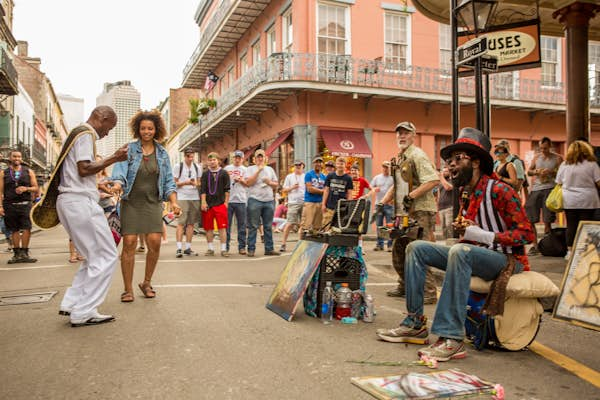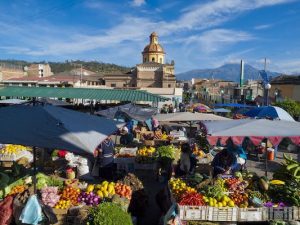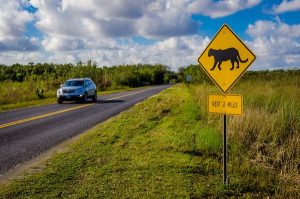
The best time to visit New Orleans is whenever you’re feeling like you need to add some fun and random beautiful chaos to your life, because this city manufactures good times in overdrive. Good times aside, you probably want to arrive at the fun factory when the weather is pleasant.
When it comes to New Orleans climate, there are basically two seasons: summer and not-summer. Summer lasts from May until October but can rear its muggy head at any time of the year: 80°F (26°C) days in the middle of a 50°F (10°C) week in winter are definitely a thing. Keep in mind that most of summer also overlaps with hurricane season, which has its own climatic footnotes. Meanwhile, “not-summer” (October to April) can include a surprisingly chilly winter, bracketed by a roughly two-month long, gorgeous spring on the one end, and an autumn that lasts maybe three days on the other (we’re exaggerating, but only just).
But “best time to visit” is not just a question of climate. There are other major concerns when visiting New Orleans, namely: what festivals are happening, and how many formal opportunities will exist for overindulgence? Spoiler alert: something will be happening, and yes, you can always have too much of a good thing. Read on to find out how, and more importantly, when.
Squeeze every moment out of your next vacation with tips and tricks from Lonely Planet in our weekly newsletter delivered to your inbox.  Marching bands fill the streets for Mardi Gras © Lori Monahan Borden / Shutterstock
Marching bands fill the streets for Mardi Gras © Lori Monahan Borden / Shutterstock
January to mid-March: It’s Carnival Tiiiiiime
The above is the hook for Al Johnson’s masterpiece Carnival Time, which was recorded in 1960 and, some six decades later, remains the definitive Mardi Gras banger (OK, yes, it shares the title with Professor Longhair’s Go To the Mardi Gras). If you’re from outside Louisiana you might think Mardi Gras is a one-day party, but you’d be mistaken. While Mardi Gras French for Fat Tuesday – is just the one Tuesday, it caps off the whole Carnival season, which lasts from Twelfth Night/The Feast of the Epiphany (January 6) until the day before Ash Wednesday. That latter date is set by the Catholic liturgical calendar – you can get a list of upcoming Mardi Gras dates here, but the holiday always hits in February or early March.
Carnival begins with the streetcar procession of the Phunny Phorty Phellows, and then continues to grow in fever-dream fantasy, with parades like the science fiction-themed Chewbacchus, and culminates in the five days before Mardi Gras, when everything in the city shuts down, everyone throws on a costume and the greater New Orleans metro area becomes an explosion of glitter, costuming and king cake.
Which is all to say: Carnival season is a ton of fun. If you’re coming from up north, the weather will almost certainly be warmer than what you’re used to, although the high humidity of South Louisiana makes the chill of 50°F (10°C) feel a lot more bitter than you’d expect – on the flip side, 70°F (21°C) or warmer days are certainly not unknown. Rates for everything, of course, are high – and you’ll want to make any sort of bookings, be it for accommodation or dining, well in advance.
 A group of musicians playing at the Fritzel Jazz Club in the French Quarter © CHANDAN KHANNA /AFP / Getty Images
A group of musicians playing at the Fritzel Jazz Club in the French Quarter © CHANDAN KHANNA /AFP / Getty Images
Mid-March to May for the best festivals
Lent begins the day after Mardi Gras, but big communal celebrations are decidedly not on the list of things New Orleans gives up. Spring in the city heralds festival season, marked by two big-name events: the French Quarter Festival (which is free!) and the New Orleans Jazz & Heritage Festival (ie, Jazzfest), and sprinkled by several smaller parties. The weather approaches chef’s kiss perfection at this time; Louisiana spring is sort of like the golden days of early summer in many other parts of the country.
Are room rates high? Definitely, and anything that can be booked should be done so well in advance. But in return, you’re getting good weather and great live music around the clock, and the city just feels like it’s in a good mood. In addition, on the last weekend of April, Lafayette in Louisiana, some 140 miles west of New Orleans, hosts Festival International de Louisiane, a rollicking free festival that celebrates Francophone music and heritage.
The summer slog of high heat and humidity settles in around mid-May, but prices don’t drop until after Memorial Day weekend.
 The roller-skating Running of the Bulls is a uniquely New Orleans event © Emily Kask / AFP via Getty Images
The roller-skating Running of the Bulls is a uniquely New Orleans event © Emily Kask / AFP via Getty Images
June to September means summer heat and hurricanes
Summer in New Orleans is, to be frank, interminably long and pretty miserable. Temps regularly hit the 90s (32°C), but high humidity means the real feel is often in the triple digits. It can feel hard to breathe, and being outside for longer than 30 minutes means dealing with copious amounts of sweat. The main relief comes from thunderstorms: the humidity swells and swells until it gets swept away by a dramatic storm. On top of everything, hurricane season starts, and while it technically lasts from June through November, peak hurricane time in South Louisiana is August and September.
Why visit at this time? Well, it’s as cheap as New Orleans gets. Waitstaff and hospitality workers tend to seem a little friendlier, a nod of respect to those who come here during the swelter. And there are parties, like the chichi White Linen Night, and the more down-to-earth Dirty Linen Night (both art gallery extravaganzas).
There’s also the New Orleans Running of the Bulls (featuring roller derby skaters), the Essence Music Festival, Satchmo Summerfest, and Southern Decadence (the city’s most energetic LGBTQIA+ festival) takes place over Labor Day weekend. You’re a lot more likely to rub shoulders with a local during a show and there is a sweaty romance in the air on those long, sticky summer nights. Then, in September, New Orleans usually experiences a “false fall” (we just call it “Fallse”) when temps drop to 70°F (21°C) before the heat comes raging back for a few more weeks.
 A historic New Orleans mansion decked out for Halloween © Xinhua News Agency / Getty Images
A historic New Orleans mansion decked out for Halloween © Xinhua News Agency / Getty Images
October to December for the best of fall, with Halloween and Christmas
There is no wishful thinking like the Louisiana family that hangs an autumnal wreath come late September, when the real feel still regularly tops 100 degrees (38°C). Still, by October the hellish heat gets broken up with cooler days, “cooler” here meaning 80-ish degrees (26°C). It’s not unusual for the air-con to be switched on on Halloween day, although sometimes Spooky Season in the Crescent City is decently temperate.
Either way, Halloween is fun in New Orleans, a time when costuming and silliness and defiant celebration manifests itself after the looong summer. Rates go up Halloween weekend but drop again in November, itself a generally quiet month and an excellent time for exploring the city free of the trifecta of heat, hurricane threats and high season rates. Indeed, if you’re into just having a (relatively) quiet New Orleans experience of strolling and admiring historical buildings, November is tough to beat.
Christmas is big in New Orleans, and while the weather will often top 70 degrees (21°C), there are days that drop into the 50s (10°C) and 40s (4°C), which feels cold in that humid air. December in New Orleans is all about hitting up holiday parties and celebrations, and while rates climb back up in anticipation of Carnival season, this is more or less a shoulder window with the added bonus of sincere, warm family cheer.



